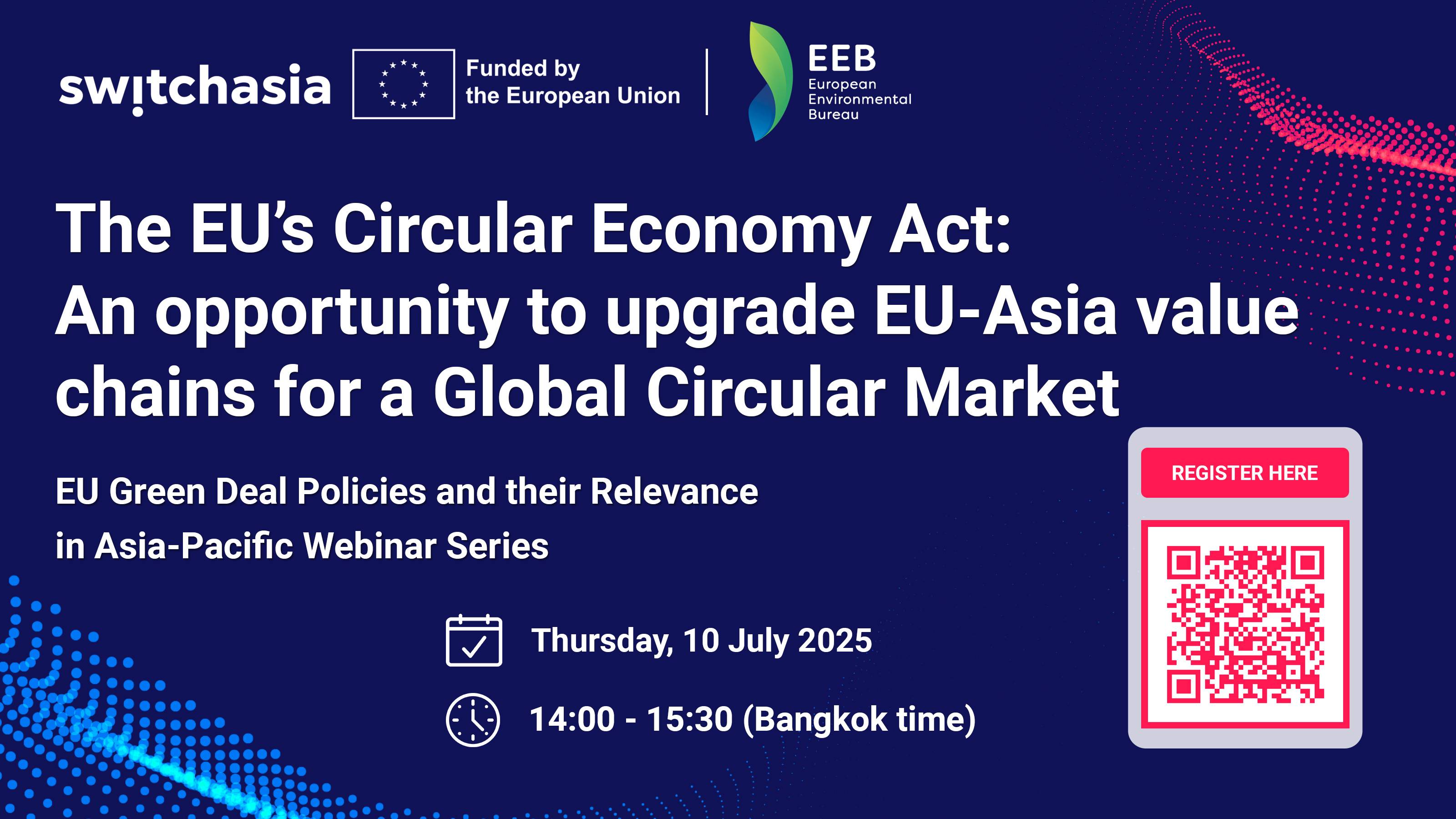Report on European Union Circular Economy Initiatives and Alignment with Sustainable Development Goals
Introduction: Advancing the 2030 Agenda
The European Union is advancing its commitment to the Sustainable Development Goals (SDGs) through a comprehensive legislative framework aimed at transitioning to a circular economy. These initiatives, primarily the upcoming Circular Economy Act and the existing Circular Economy Action Plan, are designed to fundamentally reshape production and consumption patterns, directly contributing to several key SDGs, including SDG 12 (Responsible Consumption and Production), SDG 9 (Industry, Innovation, and Infrastructure), SDG 11 (Sustainable Cities and Communities), and SDG 13 (Climate Action).
The Forthcoming Circular Economy Act
The Circular Economy Act, scheduled for adoption in 2026, represents a critical step in achieving a resource-efficient and climate-neutral economy. Its primary objectives are intrinsically linked to the SDGs:
- Establish a Single Market for secondary raw materials: This supports SDG 9 by fostering sustainable industrialization and innovation in resource recovery infrastructure.
- Increase the supply of high-quality recycled materials: This measure directly addresses SDG 12 by promoting the reduction of waste generation through prevention, reduction, recycling, and reuse.
- Stimulate demand for recycled materials: By creating market incentives, this objective promotes sustainable economic growth and green jobs, aligning with SDG 8 (Decent Work and Economic Growth).
The Act is a cornerstone of the EU’s ambition to become a global leader in the circular economy by 2030, reinforcing its commitment to the global 2030 Agenda for Sustainable Development. A public consultation on this Act was initiated in August 2025 to ensure broad stakeholder engagement, reflecting the principles of SDG 17 (Partnerships for the Goals).
The Circular Economy Action Plan (2020) as a Foundation
The upcoming Act builds upon the second Circular Economy Action Plan (CEAP), adopted in March 2020 as a main component of the European Green Deal. The CEAP provides a foundational strategy for achieving sustainability goals through the following measures:
- Addressing the entire life cycle of products: By focusing on sustainable product design, the plan ensures that resource efficiency and waste prevention are considered from the outset, a core tenet of SDG 12.
- Preventing waste and retaining resource value: The emphasis on keeping used resources within the EU economy for as long as possible is crucial for reducing the environmental footprint of consumption and production, contributing to SDG 11 and SDG 13.
- Implementing legislative and non-legislative measures: The plan targets key sectors to ensure a systemic shift towards circularity, demonstrating a comprehensive approach to sustainable development.
Key Metrics and Targets for SDG 12
A central metric for tracking progress is the circularity rate, which measures the proportion of material resources used in the economy that come from recycled waste materials. This provides a tangible indicator for progress on SDG 12.2, which calls for the sustainable management and efficient use of natural resources.
- Current Status: The EU’s circularity rate is approximately 12%.
- 2030 Target: The EU aims to double the circularity rate to 24% by 2030.
This ambitious target, part of the EU’s Clean Industrial Deal, quantifies the commitment to decoupling economic growth from resource use and accelerating the transition to a low-waste, climate-neutral economy in line with the Sustainable Development Goals.
Analysis of the Article in Relation to Sustainable Development Goals
1. Which SDGs are addressed or connected to the issues highlighted in the article?
SDG 12: Responsible Consumption and Production
- The article is centered on the EU’s Circular Economy Act and Action Plan, which directly aligns with SDG 12. The core objective is to shift from a linear (take-make-dispose) model to a circular one, which is the essence of sustainable consumption and production. The text explicitly mentions creating a “resource-efficient, low-waste” economy, preventing waste, and keeping “used resources in the EU economy for as long as possible.”
SDG 9: Industry, Innovation, and Infrastructure
- The article discusses the ambition to make the “EU the world leader in the circular economy by 2030” and references the “Clean Industrial Deal.” This points to upgrading industries and infrastructure to be more sustainable and resource-efficient, a key component of SDG 9. Establishing a “Single Market for secondary raw materials” is an innovation in industrial infrastructure and processes.
SDG 8: Decent Work and Economic Growth
- The article frames the circular economy as Europe’s agenda for “sustainable growth.” This connects to SDG 8’s aim to promote economic growth that is sustainable and decoupled from environmental degradation. The “Competitiveness Compass” mentioned in the article further reinforces the link between the circular economy model and economic prosperity.
SDG 13: Climate Action
- The goal of achieving a “climate-neutral economy” is explicitly stated. A circular economy contributes directly to climate action by reducing emissions associated with raw material extraction, processing, manufacturing, and waste management. By increasing resource efficiency and reducing waste, the EU’s plan helps mitigate climate change.
2. What specific targets under those SDGs can be identified based on the article’s content?
Target 12.5: By 2030, substantially reduce waste generation through prevention, reduction, recycling and reuse.
- The article directly addresses this target by focusing on measures to “increase the supply of high-quality recycled materials,” ensure “waste is prevented,” and keep resources in use for as long as possible. The central goal to “double” the circularity rate is a clear strategy for reduction, recycling, and reuse.
Target 12.2: By 2030, achieve the sustainable management and efficient use of natural resources.
- The plan’s aim to accelerate Europe’s shift to a “resource-efficient” economy is a direct reflection of this target. The concept of a circular economy, where materials are reused and recycled, is the primary mechanism for achieving the efficient use of natural resources.
Target 9.4: By 2030, upgrade infrastructure and retrofit industries to make them sustainable, with increased resource-use efficiency and greater adoption of clean and environmentally sound technologies and industrial processes.
- The article’s mention of the “Clean Industrial Deal” and the creation of a “Single Market for secondary raw materials” aligns with this target. These initiatives represent a systemic upgrade of industrial processes to increase resource efficiency and build a sustainable industrial base.
Target 8.4: Improve progressively, through 2030, global resource efficiency in consumption and production and endeavour to decouple economic growth from environmental degradation.
- The article links the circular economy to “sustainable growth” and “competitiveness.” This demonstrates an effort to decouple economic activity from resource consumption and environmental impact, which is the core principle of Target 8.4.
3. Are there any indicators mentioned or implied in the article that can be used to measure progress towards the identified targets?
Mentioned Indicators
- Circularity Rate: The article explicitly identifies the “circularity rate” as a key metric. It is defined as a measure of “how much of the materials we use are recycled or reused instead of being thrown away.” The article provides a baseline (12%) and a clear, measurable target: to “double it to 24% by 2030.” This indicator directly measures progress towards targets 12.5, 12.2, and 8.4.
Implied Indicators
- Supply of secondary raw materials: The article states a goal to “increase the supply of high-quality recycled materials.” This implies an indicator that could measure the volume (e.g., in tonnes) or market share of secondary raw materials used in production, which would track progress towards Target 9.4.
- Waste Generation Levels: The focus on a “low-waste” economy and ensuring “waste is prevented” implies that a reduction in the total amount of waste generated would be a key measure of success, directly relating to Target 12.5.
4. Summary Table: SDGs, Targets, and Indicators
| SDGs | Targets | Indicators |
|---|---|---|
| SDG 12: Responsible Consumption and Production | 12.5: Substantially reduce waste generation through prevention, reduction, recycling and reuse. | Circularity Rate (Explicitly mentioned as the measure of recycled/reused materials, with a target to double to 24% by 2030). |
| SDG 12: Responsible Consumption and Production | 12.2: Achieve the sustainable management and efficient use of natural resources. | Circularity Rate (Measures how efficiently resources are kept within the economy). |
| SDG 9: Industry, Innovation, and Infrastructure | 9.4: Upgrade infrastructure and retrofit industries to make them sustainable, with increased resource-use efficiency. | Supply of high-quality recycled materials (Implied by the goal to increase its supply and create a market for it). |
| SDG 8: Decent Work and Economic Growth | 8.4: Improve resource efficiency in consumption and production and decouple economic growth from environmental degradation. | Circularity Rate (A direct measure of resource efficiency, linking economic activity to material reuse rather than new extraction). |
| SDG 13: Climate Action | Contributes to overall climate goals by promoting a “climate-neutral economy.” | Progress in the circular economy (measured by the Circularity Rate) serves as an indirect indicator of reduced emissions from production and waste. |
Source: environment.ec.europa.eu







